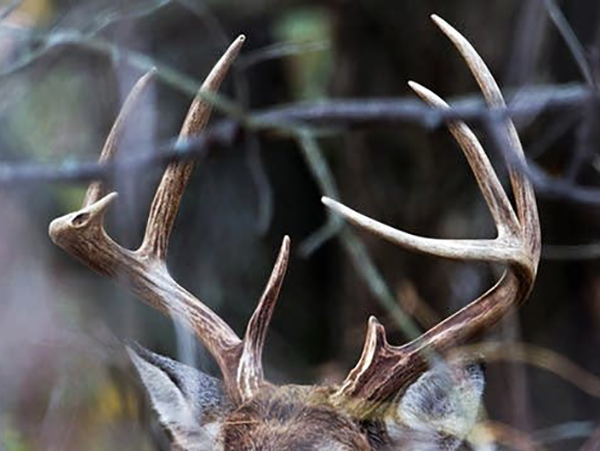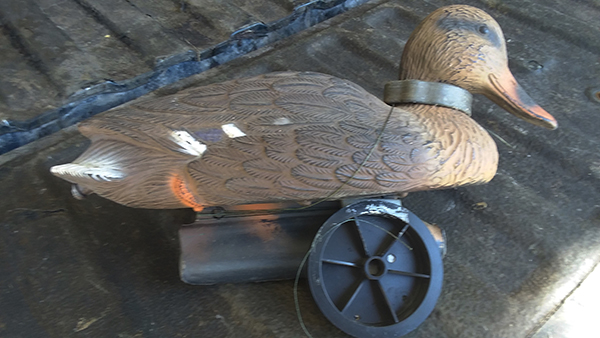Deer testing finds additional cases of CWD

By Minnesota DNR Reports
A wild deer harvested in Dakota County on Nov. 7 and a vehicle-killed deer in Olmsted County on Nov. 4 were confirmed positive for chronic wasting disease. To date, 95 wild deer have tested positive for CWD in Minnesota.
The case of the Dakota County deer, an adult male, marks the first time the fatal neurological disease has been detected in a hunter-harvested wild deer in the newly established south metro disease management zone. The deer was harvested less than a mile from a CWD-positive wild deer discovered in March and was tested after the hunter provided the sample as part of the DNR’s voluntary sampling program.
The Olmsted County deer, an adult female, appeared to suffer injury from a vehicle before dying in Rochester. The resident who reported the dead deer brought the carcass to be sampled by DNR staff for CWD testing. While this is not the first wild deer to have the disease within deer permit area 643, it is the farthest northwest that CWD has been found in the southeast disease management zone.
The DNR has notified the hunter and resident who submitted the deer for sampling of the positive test results, and the meat and carcasses from both deer have been properly disposed.
“It’s concerning to see these two positive test results. We will continue gathering data to see how prevalent the disease is in these areas, and maintain our aggressive management response,” said Michelle Carstensen, DNR’s wildlife health program supervisor.
The DNR continues to collect samples from hunter-harvested deer in designated areas during all hunting seasons to help monitor the spread of the disease. Hunters in CWD management zones, control zones or surveillance areas are urged to drop off the head of deer 1 year of age or older at self-service sampling stations.
“We’re grateful to hunters and other Minnesotans for providing samples to test for this disease and help safeguard the health of our wild deer population,” Carstensen said. “These two positive test results are unfortunate, but highlight the importance of our sampling efforts in getting information that shows us how prevalent the disease is in an area. We urge hunters to continue bringing deer to sampling stations. Every sample counts.”
As part of its CWD response plan, the DNR is monitoring for CWD in disease management zones around areas that CWD has been detected in wild deer, as well as in CWD surveillance areas where CWD has been found in captive deer. The CWD management zones are located in the southeast, north-central and south metro areas of Minnesota; the CWD surveillance areas are located in the east-central, west-central and south metro areas of Minnesota.
Record success rate for Camp Ripley archery deer hunts

By Mn DNR Reports
Archery hunters who participated in the Camp Ripley hunts near Little Falls harvested 310 deer and had a record success rate during the event held Oct. 15 to Oct. 16 and Oct. 31 to Nov. 1.
“It was an exceptional event this year,” said Dr. Bill Faber, head of the Central Lakes College Natural Resources Program. “Despite fewer participants, the harvest was up 11.5% from last year; and above the 40-year average of 305 deer.” During the hunts, 16% of archers harvested a deer, representing an unprecedented success rate at Camp Ripley. The rate is well above the long-term average of 9%.
This year, 1,864 participating hunters harvested 310 deer. During the 2019 hunts, 2,137 hunters harvested 278 deer. This year, hunters harvested at least 25 large, antlered bucks (greater than 8% of total harvest) during the event, well above the 3.5% long-term average of total harvest. The largest was a 16-point buck that a hunter checked in on the last day.
The Minnesota DNR modified some aspects of this year’s hunt as a result of the COVID-19 pandemic. Administration of the event went well and without any major issues, said Beau Liddell, DNR wildlife manager at Little Falls.
The archery hunt at Camp Ripley is an annual event. The DNR coordinates the hunts in collaboration with Central Lakes College Natural Resources Program and the Department of Military Affairs, which manages the 53,000-acre military facility.
Braided fishing line and duck decoys are a bad mix

By Mike Schoonveld
Recently, I needed to replace the anchor lines on several of my duck decoys. There are several kinds available but being old school, I just use the old fashioned dark brown or green nylon cord. I usually have some; I thought I had some but if so, it had been misplaced. However, while checking in various drawers and other hidey-holes, I came upon a spool of 150 pound test braided fishing line. Why I had a spool of 150-pound line is another story.
Colored a deep, almost black-green, the color was perfect and being about 100 times thinner than my usual decoy anchor cord, it would be undetectable to the ducks. I often hunt for the smartest-ever ducks which, I’m sure, always circle a flock of ducks before landing with them, checking to see if any of them look to have anchor lines attached to their bellies.
The 150-pound-test line would certainly be strong enough. I’m not sure of the test-strength of regular decoy string, but since my anchors weigh only about a quarter-pound, I knew 150 pounds strong would do.
Great idea, eh?
Partially great, mostly a disaster.
Great first. It proved strong enough. Second, I hunted with those decoys several days. Not one duck flared from spotting the anchor lines.
The bad, starting with setting the decoys in the dark. Even with a headlamp on my hat, the line was hard to see. Seeing it was plenty easy in the direct beam, but in the shadows it disappeared.
Wearing gloves – you better be wearing gloves with this line – it was hard to grip. Bare fingered, the risk of getting a line cut is real – even 150 test is thin enough to cut through skin. Want to see my scars?
I use strap anchors which wrap around the decoy’s neck to keep the anchors from dangling and tangling. It works about 11 out of 12 times, with any kind of decoy line. But I was hunting using three dozen decoys. Do the math.
I don’t know which was worse, untangling a braided line tangled with a nylon cord anchor line or untangling two braided line anchor rodes. Neither added much contentment to the morning.
One last downside to the braided anchor line. It has to do with inadvertently running over the braided line with an electric trolling motor. Not good, but an outboard would have been worse. Luckily, from one sense, the outboard wouldn’t start.
Take heed, my duck hunting friends. Stock up with decoy line and store it where it can be found when needed. When in need, and all duck hunters will be in need eventually, forgo using braided fishing line as a substitute. Some plans just won’t fall into place.
A shot too far

By Mike Raykovicz
I spoke to a good friend who has never hunted with a bow and arrow until he bought a crossbow two years ago. We discussed how the season played out and he told me he shot a beautiful ten point a few days before the archery season ended. I was happy for him because of his fine trophy, but my elation soon turned to concern after he told me the details of the hunt.
“I was hunting a friend’s farm and saw this buck step out of the woods and he began feeding in the picked corn field,” my friend informed me. He went on to explain how he put the crosshairs behind the buck’s shoulder and squeezed the trigger. “It was a great shot and he didn’t go far,” my friend said. What concerned me though was the distance he said he shot the deer. “85 yards,” he said with a big smile.
Being a gun hunter for almost fifty years my friend thought nothing of taking an 85-yard shot even if it was with a crossbow. I felt I had to say something.
“Deer are quick, agile and nervous creatures who you know are constantly alert to danger. An arrow is not a bullet, and in the amount of time it takes an arrow to reach a seemingly calm deer, the animal can react to the sound of the shot and it could lead to a totally unwanted result,” I explained.
I went on to tell him that most experienced bowhunters have had deer duck the string at the sound of the shot and the results are almost never good. I went on to explain that in addition to taking a shot this long the arrow is at the mercy of the wind and even a slight gust or perhaps an unseen twig could affect its flight resulting in a wounded animal.
No one wants to gut shoot a deer or to lose one so, at the risk of sounding like I was envious of his success and that I was preaching to an experienced hunter, I risked voicing my opinion further about taking a shot that long and calmly enumerated the things that could have gone wrong. Thankfully, my friend wasn’t offended and hopefully what I said sunk in.
I can’t blame him or anyone else for that matter for taking long shots at deer because several manufacturers of crossbows tout their accuracy out to a hundred yards. It was last season when one crossbow manufacturer placed ads in several outdoor magazines that said, “Meet your new rifle.”
Another manufacturer boasted minute of angle accuracy from their top-of-the-line crossbow model. Personally, I was taken aback by these ads because in my opinion they were sending the wrong message to newly minted bowhunters. Before the letters come pouring in about this being an anti-crossbow piece, it is not. It makes no difference to me as to what device a person uses to hunt deer because these decisions are personal.
My concern is that taking too long a shot or taking a questionable shot can possibly result in a positive outcome such as in my friend’s case, or it can make us regret our decision. To some, killing a deer and then assuming “bragging rights” is all that matters, but personal ethics will enable us to sleep better at night knowing the long shot we passed up means the hunt can continue and that a fine animal won’t be wasted.
Michigan DNR sees spike in hunting amid pandemic

By Associated Press
ROYAL OAK, Mich. — A renewed interest in hunting has dramatically increased since March when the coronavirus pandemic hit across the U.S., forcing businesses to shut down and people to stay home, according to statistics from the Michigan DNR.
So far, the DNR has issued 751,310 deer hunting licenses, compared to 584,802 licenses issued in 2019, The Daily Tribune reported. Many hunters also acquired multiple licenses for the various deer hunting seasons – antlerless, firearms, or archery.
A mid-September report from the Michigan DNR indicates that overall participation in deer hunting is up 26.97% over the same time as last year, and overall participation in hunting is up 121.61%.
While the final numbers for 2020 won’t be known until end of the year, the DNR said its biggest day for issuing hunting licenses is usually the weekend before the regular firearm deer season begins in mid-November.
The increase in hunters is good as particularly when it comes to deer hunting, there have been fewer hunters in recent years as older people “age out” and fewer younger people don’t have the time or may have other priorities. The DNR relies on hunters to manage and cull the state’s estimated 1.7 million deer population.
“We’re very excited about this,” said Kristin Phillips, chief of marketing and outreach for the Michigan DNR. “I’m trying to keep my expectations in check.”

